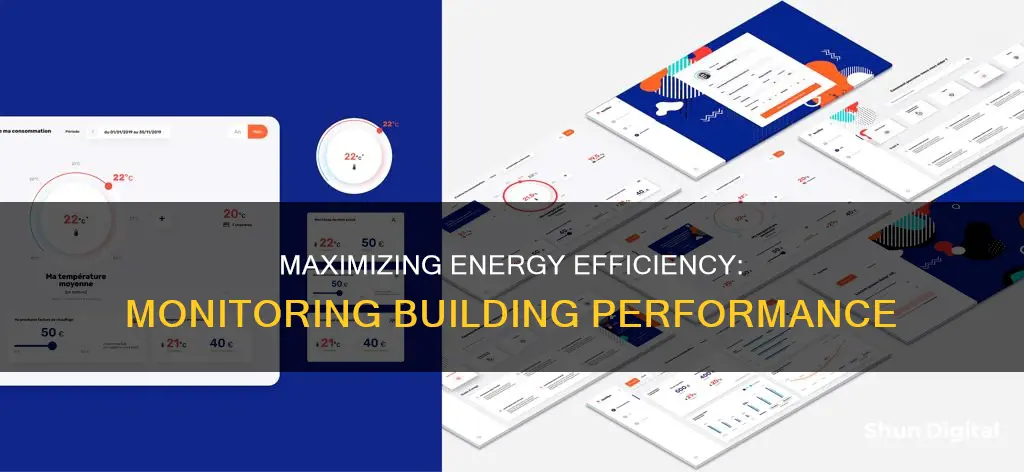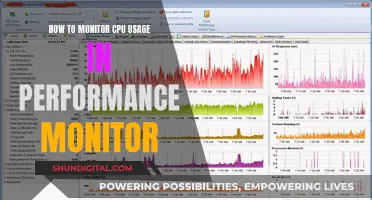
Monitoring a building's energy performance is essential for managing energy use, costs, and productivity. It involves tracking and analyzing energy consumption and generation, identifying areas for improvement, and implementing solutions to optimize energy efficiency. Several methods and tools are available for monitoring building energy performance, including energy audits, energy modeling, energy rating systems, and energy monitoring systems. These tools help building owners and managers benchmark their buildings' energy performance, identify inefficiencies, and make informed decisions to reduce energy consumption and costs. Additionally, monitoring building energy performance is crucial for sustainability and reducing greenhouse gas emissions. By understanding how a building uses energy, stakeholders can make necessary improvements, contributing to a greener and more cost-effective future.
| Characteristics | Values |
|---|---|
| Energy Performance Certificates | A document that rates the energy efficiency of a building on a scale from A (most efficient) to G (least efficient) |
| Energy Audits | A detailed analysis of a building's energy use and demand, performed by a qualified professional |
| Energy Modeling | A computer simulation of a building's energy behaviour, based on its design, location, orientation, materials, systems, and occupancy |
| Energy Monitoring | Collecting and analyzing data on a building's energy consumption and generation in real time using meters, sensors, software, and dashboards |
| Energy Benchmarking | Comparing a building's energy performance with similar buildings, past consumption, or a reference performance level |
| Energy Rating Systems | Frameworks that assess and certify the energy performance of a building, such as LEED, BREEAM, ENERGY STAR, and Passive House |
| Energy Dashboards | A visual display of a building's energy performance in real time or over a period, using data from smart meters, sensors, or energy management systems |
| Energy Feedback | Providing information and guidance to building occupants about their energy use and its consequences through reports, bills, apps, or displays |
| Standardization | Standard definitions for metrics, providing a consistent basis for comparing energy performance among buildings |
| Versatility | Customizing the analysis to the specific boundaries, energy configuration, goals, and budget of a project |
| Efficiency in Data Collection | Matching data collection with analysis goals to avoid too little or too much information |
What You'll Learn

Energy Performance Certificates
EPCs rate a building's energy efficiency on a scale from A (most efficient) to G (least efficient). They also provide recommendations on how to improve the energy performance of the building, such as installing insulation, upgrading heating systems, or using renewable energy sources. The certificates are valid for 10 years and can be obtained from an accredited assessor.
In addition to providing valuable information to property owners, tenants, and potential buyers, EPCs are also useful for real estate developers. They can help attract tenants or buyers who are looking for greener and cheaper properties. Furthermore, they can be used to benchmark a building's energy performance against similar buildings, track progress, and demonstrate compliance with energy codes and standards.
For those looking to sell or rent out their homes, EPCs are a legal requirement. Failure to obtain an EPC can result in a fine. The certificate must be displayed somewhere in the property, such as in the meter cupboard or next to the boiler, and it should be made available to potential buyers or tenants.
Removing Mini Source Monitor in Adobe Premiere: A Step-by-Step Guide
You may want to see also

Energy Audits
There are two main types of energy audits: preliminary and investment-grade or detailed audits. A preliminary energy audit, also known as a walkthrough audit, involves a simple inspection of the building premises to identify energy usage and performance. This type of audit requires minimal measurements or data collection and can be completed quickly. However, it can still reveal valuable insights and opportunities for enhancing energy efficiency.
On the other hand, investment-grade or detailed energy audits provide a more in-depth analysis of various energy systems, such as pumps, fans, compressed air, and steam. These audits are more time-intensive and comprehensive, offering precise insights into energy performance and specific recommendations for improvements.
The process of an energy audit typically includes several steps:
- Preparation: Gathering information about the building, such as its age, size, occupancy patterns, and energy usage history.
- Walkthrough inspection: Conducting a visual inspection to identify potential energy-saving opportunities, such as air leaks, insulation levels, lighting systems, and energy-using equipment.
- Energy consumption analysis: Analyzing energy consumption data to identify patterns and trends in energy use.
- Equipment and systems assessment: Assessing the energy efficiency of equipment and systems, such as HVAC, lighting, and appliances, to identify inefficiencies.
- Recommendations: Based on the findings, auditors provide recommendations for energy-saving measures, such as installing energy-efficient equipment or improving insulation.
- Implementation: Working with building management to implement the recommended energy-saving measures.
- Monitoring and evaluation: Continuously monitoring the building's energy use and evaluating the effectiveness of the implemented measures, making adjustments as necessary.
Easy Holter Monitor Setup: 5-Lead Connection Guide
You may want to see also

Energy Benchmarking
The first step in energy benchmarking is to gather data on the building's energy consumption and production. This includes understanding how and when different systems and equipment within the building consume energy. By collecting and analyzing this data, stakeholders can establish a baseline to track improvements and identify areas requiring optimization.
The next step is to normalize the data and compare it to a relevant benchmark. This could involve matching the building's performance against similar buildings in terms of size, usage, and location. This comparison enables the identification of "energy hogs" within the building, highlighting systems or equipment that contribute significantly to energy waste.
With the insights gained from benchmarking, building managers can prioritize upgrades and set realistic, achievable goals for improving energy efficiency. For example, they may discover that certain equipment is consuming excessive energy due to inefficiencies or malfunctions, prompting them to repair or replace it with more energy-efficient alternatives.
Additionally, energy benchmarking is a dynamic process that should be repeated over time to track progress. By regularly benchmarking, building owners can verify the effectiveness of their energy improvement measures and make adjustments as needed to stay on course with their sustainability goals.
In conclusion, energy benchmarking serves as a strategic tool, guiding buildings towards improved energy performance and ensuring they remain competitive, efficient, and committed to continuous enhancement. It empowers stakeholders to make data-driven decisions, allocate resources effectively, and maximize the benefits of their energy efficiency investments.
Fixing LCD Dark Spots: Can They Be Removed?
You may want to see also

Energy Monitoring
There are various methods and tools available for energy monitoring. One common approach is to utilize smart meters, which measure and monitor gas and electricity usage, displaying the data online. Smart clamp-on energy meters are employed to measure motor electricity use, while smart submeters focus on specific equipment. Circuit-breaker meters, on the other hand, are used to measure electricity consumption in a particular area or piece of equipment.
Another tool for energy monitoring is an energy dashboard, which provides a visual display of a building's energy performance in real time or over a specific period. It utilizes data from smart meters, sensors, or energy management systems to present an interactive and user-friendly overview. This helps building managers and occupants alike to detect and diagnose any issues promptly.
Additionally, energy feedback plays a crucial role in influencing and motivating occupants to reduce their energy consumption. This can be delivered through various channels, such as reports, bills, apps, or displays, and can include historical or comparative data, tips for improvement, or even rewards for energy-saving achievements.
For more detailed analysis, energy monitoring can be conducted at finer levels, such as the building, equipment, system, or process level. This allows for a more granular understanding of energy consumption and can help identify deviations from expected energy performance, providing early warnings of potential issues.
Regular monitoring and analysis of performance metrics are essential to making effective decisions on energy management. By tracking key characteristics, such as past and present energy consumption, significant energy uses, and energy performance improvement opportunities, organizations can ensure they are meeting their energy objectives and targets.
Blue Light Filter: ASUS Monitors' Eye-Care Feature Explained
You may want to see also

Energy Rating Systems
- LEED
- BREEAM
- ENERGY STAR
- Passive House
These systems provide a standardized way of comparing the energy performance of different buildings or building components. The ratings can be based on actual or estimated energy consumption or the energy efficiency of specific features such as windows, insulation, or appliances.
For example, the ENERGY STAR score compares a building's energy performance to similar buildings nationwide, normalized for weather and operating characteristics. A score of 50 represents the median performance, with a higher score being better than average.
Energy ratings are an effective tool for building owners and developers to improve sustainability, reduce energy costs, and attract eco-conscious tenants or buyers.
VA's CPAP Monitoring: How It Works and Why
You may want to see also
Frequently asked questions
An energy audit is a detailed analysis of a building's energy usage and potential savings. It involves a qualified professional or certified energy auditor inspecting the building's envelope, mechanical and electrical systems, occupant behaviour, and energy bills. The auditor uses tools like thermographic cameras, blower doors, and power meters to identify areas of energy loss or inefficiency and recommend cost-effective solutions.
Energy modelling is a computer simulation of a building's energy performance under different conditions. It helps predict energy demand, consumption, and the impact of design choices, retrofit options, and operational strategies. Software like EnergyPlus, eQUEST, or Revit is used to create and analyse these models, aiding in optimising building design, evaluating renewable energy systems, and complying with energy standards.
Energy rating systems provide a standardised way to compare a building's energy performance with others. They assess and certify energy performance based on specific criteria and requirements, helping communicate sustainability and quality to stakeholders. Examples include the Energy Star label, LEED certification, and the HERS index.
An energy dashboard is a visual display of a building's energy performance in real time or over a period. It uses data from smart meters, sensors, or energy management systems to help monitor and manage energy consumption and detect any problems. It also raises awareness and encourages occupants to adopt more energy-efficient behaviours.







